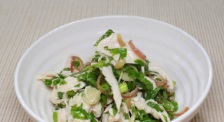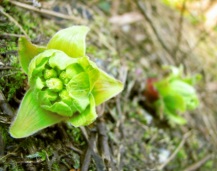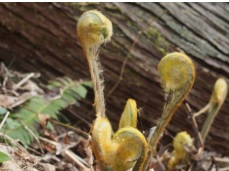According to one resource, we only have 150 plant species for food. Among them, only 3 kinds are mainly used for main energy resource.
Rice, corn, and wheat are popular plants. Besides that, tons of plants are being neglected. To make matter worse, some are even extincting.
We used to grow thousands of varieties of plants to eat. It was good in view of risk management diversify our food resources. As we know, when a pestilence hit potatoes in Ireland in 19th century, 20% of population decreased because of hunger. Things could be different if they had diversity of food resource, not solely relying on potatoes.
There are some unique Japanese vegetables we can recommend.
Japanese food is well known for healthiness. Many people think sushi or sashimi for instance. However, it is not well known that Japanese vegetables are actually contributing to the healthiness of Japanese food. Without these vegetables, it would be difficult to cook some delicious Japanese foods!
Japanese Unique Vegetables
1. Shiso (シソ) Perilla
One of well know vegetable, mostly seen with sashimi on plate. It has unique flagrance you would remember.

It has few different types, such as red color leaf type, green color leaf type, shrinking leaf type, and non shrinking leaf type. Basically their taste is quite similar.


It can be harvested through out an year. Its flower buds are tasty as well.

It is well known for natural antiseptic antibacterial power. Therefore, it is used to preserve plum (known as umeboshi or sour plum mentioned later) or served with sushi or sashimi.
Where to Get
If you stay in Japan, you can get seeds online, home center or at supermarkets.
It was originally from Myanmar and southern China, being imported into Japan long time ago. If you are living in southern part of Asia, you would come across with this vegetable in wet markets. We have seen this in Vietnam as well, in local restaurants.
When you pluck its leaves, wrap it with wet paper towel and put into fridge. It would last for a couple of days.
How to Plant
Shiso can be grown even using balcony. Suitable temperature would be around 20-23℃. It does not like dry weather. It can grow under half shadow, need some lights. When you plant seeds, it would be better to soak seeds for a night so that we can expect more sprouts.
How to Cook
Umeboshi

This is very common Japanese food, having sour taste. It is known as sour plum as well. It is quite simple to make.
- Use mature plum, not green plum.
- Spray shochu (Japanese alcohol).
- Put the plum into a bin, then make salt layer on top. Repeat the plum layer and salt layer for a couple of times.
- Wait for a week, then remove the liquid produced till you see the top of plum layer slightly.
- Put shiso (usually red leaf type) being washed, salted, and squeezed
- Add back the removed liquid in process 4
- Put lid on the plum with some weights, wait for 2 weeks
- Dry the plum and shiso outside for 3 days
Salads


It is common in Japan to put this leaf into salad.
Use as Herbs
We can use as herbs along with dishes such as noodles, sashimi, and tofu.


It goes well with meat too. Some restaurants in Japan serves menu such as below picture.

Shiso Drink

You can make this refreshing drink in following process.
- Boil shiso
- Squeeze shiso, remove them
- Add sugar and vinegar
- You can dilute the liquid and drink
2. Myoga (ミョウガ) Japanese Ginger

This is the vegetable I would like to recommend. This is originally imported from China centuries ago. We eat its flower buds as we can see in the picture above. It has unique fragrance and being said this helps to increase our power of concentration.
Where to Get
We see this being sold in online market in Japan.
Or we can get roots.
How to Plant

It can be grown under shadow. Not much sunlight is needed. You can harvest the flower buds all year round except winter time. The power of multiplying is quite strong. You can expect lots of harvest from relatively small size of roots.
How to Cook



You can eat as salad, put along with grilled fish, or with some noodles.
3. Shungiku (春菊) Garland Chrysanthemum

This plant is originally from Mediterranean area! For unknown reason, it is not eaten in those area, but in Asian countries. In China, they stir fry to eat. In Japan, they boil, or put into salad too. We can enjoy quite different taste depends on where it is produced. It is said product around Tokyo is bit bitter, from west region it is sweeter.
Where to Get
We see this being sold in online market or super markets in Japan.
春菊 種 【 たつなみしゅんぎく 】 小袋 ( 春菊の種 )
春菊 種 【 おたふくしゅんぎく 】 小袋 ( 春菊の種 )
How to Plant
It is not fitting for shungiku to ship a long distance. If we plant in our yard or balcony, we can enjoy fresh leaves all the time.
Remember this plants likes sunny weather. It might not be fitting to grow in balcony. As matter of fact we have tried in balcony, ended up no harvesting. shungiku prefers temperature around 15~20℃.
How to Cook
One of common way to eat shungiku is to put in sukiyaki. It is one of main ingredient in sukiyaki dish.

We can put this in salad as well. It goes well with sesame oil based dressing.

4. Huki (フキ) Japanese Butterbur
One of rare vegetable originally from Japan. We can eat its stem, flower buds coming out during spring time.


One popular poet wrote a poet about this plant, widely read in school text book.
Be aware we cannot eat its roots. It is toxic.
Where to Get
We can get seedling online. We see this plants growing in wild in mountain or in countryside in Japan.
(山野草)山菜 フキ(蕗) 3〜4号 (1ポット) 家庭菜園
How to Plant
It can be grown under half shadow environment. It can be grown in house garden. In winter its leaves withers, but can seen sprouts in next spring.
How to Cook


One of common way to cook is to boil this with dashi and some other ingredients. You will be addicted with this slight bitterness and flavor of forest.
5. Zenmai (ゼンマイ) Royal Fern


This is sprout of ferns. We see same kind of ingredient in Malaysia which is very tasty. Once you taste properly cooked one, you would never forget it. In Japan it is a taste of spring time.
Where to Get
We need to go to market in countryside or buy dried product like below.
How to Plant
Since it is growing in forest we cannot plant it in our own garden.
How to Cook
We need to remove the scum by boiling, and putting baking soda afterwards, wait for around 3 hours. We can stir fry with soy sauce, dashi, and mirin sauce. Some eat it by itself, others eat together with soba noodles.

6. Mitsuba (三つ葉) Trefoil

It is called as Japanese parsley too. Once we eat this we would not forget its unique flavor. It can be seen in Japan, Korea, China and other north east Asian countries.
Where to Get
If you are staying in Japan, you can get seeds online, home center or at supermarkets.
If you are staying overseas, try out the dried product for the taste.
※ You can not plant this to grow.
How to Plant
We can grow it even using our balcony. Mitsuba likes half shadow cool weather such is 10-20 ℃. Before plant it, soak the seed into water for a night. Avoid the soil being dried.
How to Cook
The famous dish we know even overseas is Cyawanmushi.

However you can put this herb to almost any other dish such is to rice, or into salads.

7. Wasabi (ワサビ)

This is also one of the famous vegetable from Japan. Without this, sushi and sashimi would be tasteless. In recent years they had a boom in Japan putting wasabi simply on top of hot rice, called “wasabi don”.
Where to Get
It is wildly growing in mountain in Japan. We can see wasabi farm in cold region in Japan too.


How to Grow
Since it need fresh cold water and cool weather it might be difficult to grow in our own place.
How to Cook
When we grate it, metal grater is commonly used. Traditionally it is said using shark skin is perfect so that we can enjoy its flavor.

8. Edamame (枝豆) Green Soy Bean


This is one of our favorite snack. It is served in bars in Japan too. You may have been disappointed eating defrosted one. Try fresh one and you will never regret.
This can be harvested by taking immature soy bean. It is not common practice in other counties but getting common in recent years.
Where to Get
In most areas, soy bean is easy to get. Below links are for your reference. In recent years, some farmers create soy beans to harvest special edamame.
How to Plant
It prefers temperature around 20-25℃, having good sunlight. Be ware for insects covering by net. They know this is healthy protein.
How to Cook
The common way to eat it is simply boil with its pods, sprinkle salt after boiling. Simple but tasty.

9. Satoimo (里芋) Taro
Originally from peninsula side of Malaysia. Now it is widely spread to Asian counties including Japan. Taro is even mentioned in ancient Rome for food.
It is cultivated in field in Japan but a report shows result it would be more productive if we cultivate in paddy field with water.


Where to Get
Planting the taro itself is the way to grow.
How to Plant
It is not difficult to grow. Properer sunlight is needed. It likes 25-30℃ temperature, wet soil condition.
How to Cook

It is usually boiled with other ingredients in Japan. Sometimes as soup, other times marinated with dashi, soy sauce and mirin.
Summery
It might be difficult to get these vegetable locally away from Japan, but you will be surprised actually you can get some of these vegetables in your own country. In those countries, it can also be seen in countryside and mostly they are considered as weed!

Now we are limiting ourselves only to few well known vegetables as food resources. It can be true available lands for these crops are limited. However it would not be the case if we are opened to variety of foods. We could have foods even to the top of mountains.



















コメント